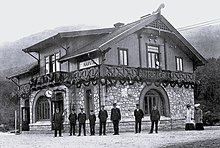Narvik train station
| Narvik | |
|---|---|
|
Narvik
|
|
| Data | |
| Platform tracks | 1 |
| opening | 1902 |
| Architectural data | |
| architect | Paul Due |
| location | |
| City / municipality | Narvik |
| province | North country |
| Country | Norway |
| Coordinates | 68 ° 26 '30 " N , 17 ° 26' 29" E |
| Railway lines | |
| List of train stations in Norway | |
The Narvik Station ( Norwegian Narvik stasjon ) is the passenger station of the city of Narvik . It is located at km 3.7 of the Ofotbahn called Norwegian section of the Luleå – Narvik railway .
The starting point for this route is Narvik H freight yard at the port of Narvik . Narvik station is the terminus for passenger traffic on the Ofotbahn and the northernmost station in Europe with standard gauge connections to the rest of the European network. There are daily train connections to Kiruna , Luleå and Stockholm , all of which are in Sweden , as the Ofotbahn line has no direct connection to the rest of the Norwegian network. Within the Norwegian section, the stations Katterat and Bjørnfjell are served by all trains.
history
Taraldsvik stasjon
During the planning of the Ofotbane, the location of today's passenger station in Narvik in the Taraldsvik district was determined and called Taraldsvik stasjon during the planning and construction phase . The station went into operation with the railway line in the autumn of 1902 and was called Narvik stasjon from the official opening by King Oscar II on July 14, 1903 .
During the construction work, locomotive 1a 13 was used for construction train services. It was awarded from Oslo to Narvik in 1901 and was in use until 1907. The laying of the rails began from Fagernes on August 26, 1901. During the summer of 1901 the locomotive drove several times a day on the Fagernes – Taraldsvik route, transporting coal, sleepers, rails and parts for the locomotive.
Station building
When the station opened in 1902, a building designed by Paul Due served as the station building.
The ground floor was built of hewn granite and fitted with arched windows, while the first floor was made of wood in the Swiss style. The construction work began in the winter of 1900 and was completed in August 1901, so that the design office could move in at that time.
A small park was created behind the station. To the west of the station was a warehouse, to the east of the station was a small house that housed the toilets. There was also the storage room for coke . Due to the increase in traffic, a new goods shed soon had to be built further east and the station building was extended.
With the electrification of the Ofotbane in 1923, a transformer station was built at the station entrance.
During the occupation of Norway in 1940, the transformer station and the new goods shed were badly damaged. During the Second World War , traffic increased due to the activities of the Germans, and a German barracks was built east of the station. After the war, the capacity of the station was no longer sufficient and it had to be enlarged. In addition to the extension of the tracks, the old station was demolished and replaced in 1951 by a new station building planned by the architects Romsloe / Noodt. The old goods shed from 1902 has been moved to Rombaksbotn.
Security systems
Narvik station got the first security system in 1944. Remote control of the route from Narvik to Bjørnfjell has been possible since July 14, 1963.
Other stations and facilities
There are several freight yards in Narvik, some of which officially have the name Narvik in their names.
The largest is LKABs Malmbeanegård , LKAB's loading station ( Luossavaara-Kiirunavaara Aktiebolag ). It is known as the Narvik ore station, which is divided into an upper and lower level. Here the iron ore - today mainly in the form of ore pellets - is unloaded from the Kiruna and Malmberget mines and then loaded onto ships.
The station Narvik H - H stands for Havn - today Narvikterminalen Fagernes or Fagernes Godsterminalen called and is the actual freight station of Narvik. This is where the Arctic Rail Express container trains end .
The station Narvik D - the D stands for Dampskipskai - today is hardly in use.
The depot for passenger trains is located immediately to the west of the passenger station. The NSB workshops and locomotive shed are located in the Gleisdreieck between Fagerneslinjen and the lower LKABs loading station. The LKAB workshops and locomotive shed on the port line are located between the lower LKABs loading station and Narvik D.
literature
- Thor Bjerke, Tore Haugen, Finn Holom, Ove Tovås: Banedata 2013 - Data om infrastructures til jernbanene i Norge . Ed .: Norsk Jernbaneklubb. Hamar / Oslo 2013, ISBN 978-82-90286-35-9 .
Web links
- Narvik train station on jernbaneverket.no
- Narvik Station on NSB.no
- Narvik train station on njk.no
- Narvik train station on kulturminnesok.no
Individual evidence
- ↑ NSB steam locomotive type 1a. gamlenarvik.no, accessed September 2, 2015 (Norwegian).
- ↑ Narvik Tidende. August 14, 1901.
- ↑ a b Km 03.70 Narvik Stasjon historie. gamlenarvik.no, accessed September 2, 2015 (Norwegian).
- ↑ Banedata 2013, p. 178.
- ↑ Banedata 2013, p. 16.
- ↑ Banedata 2013, p. 19.


